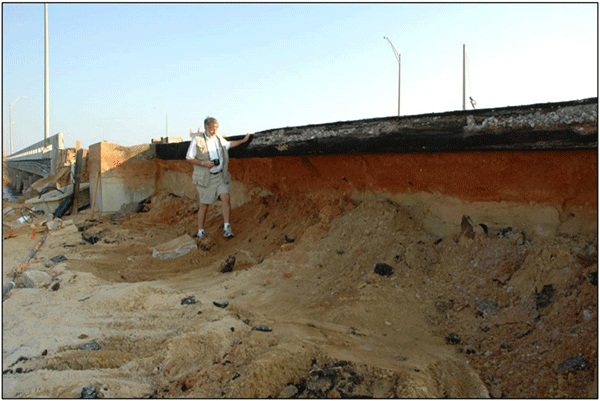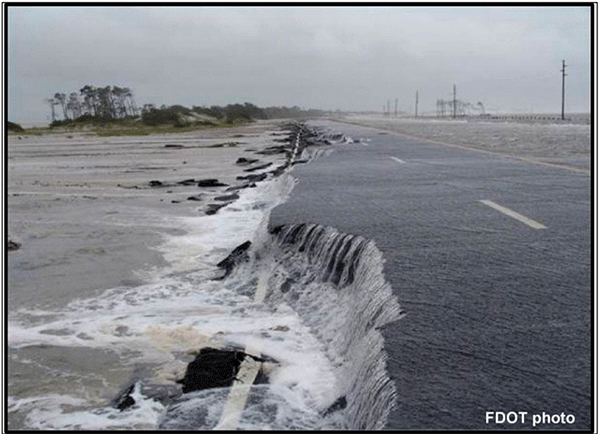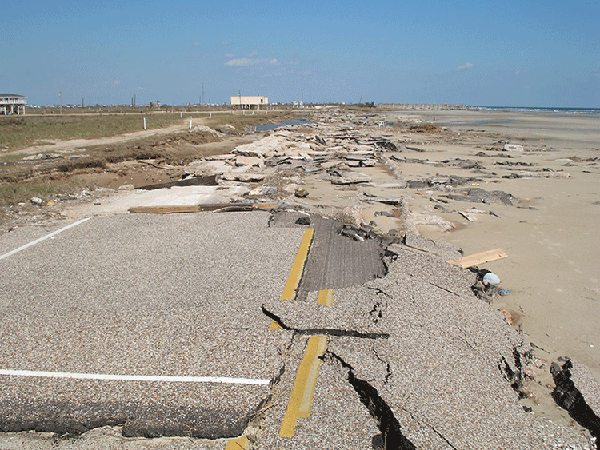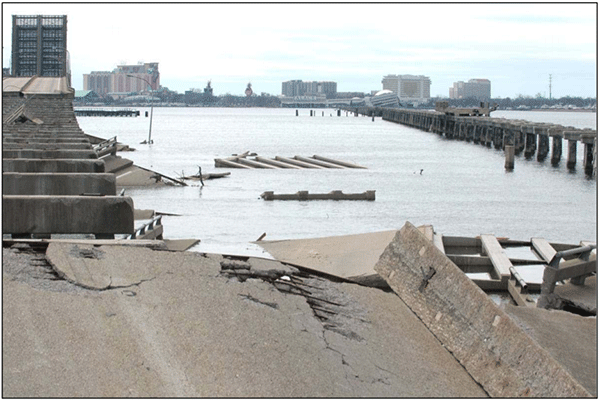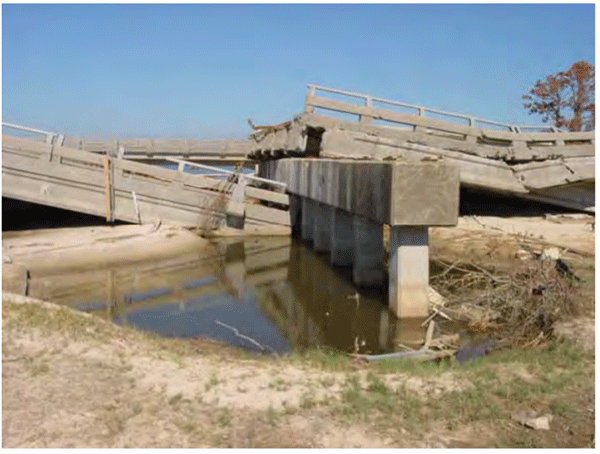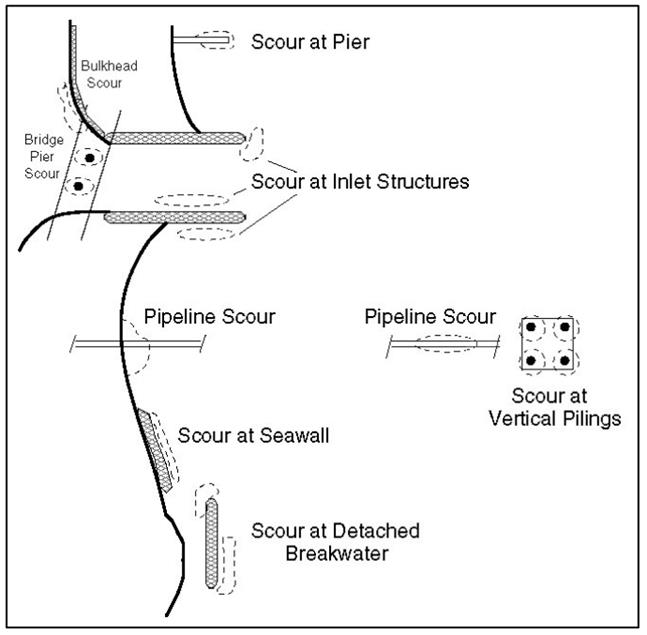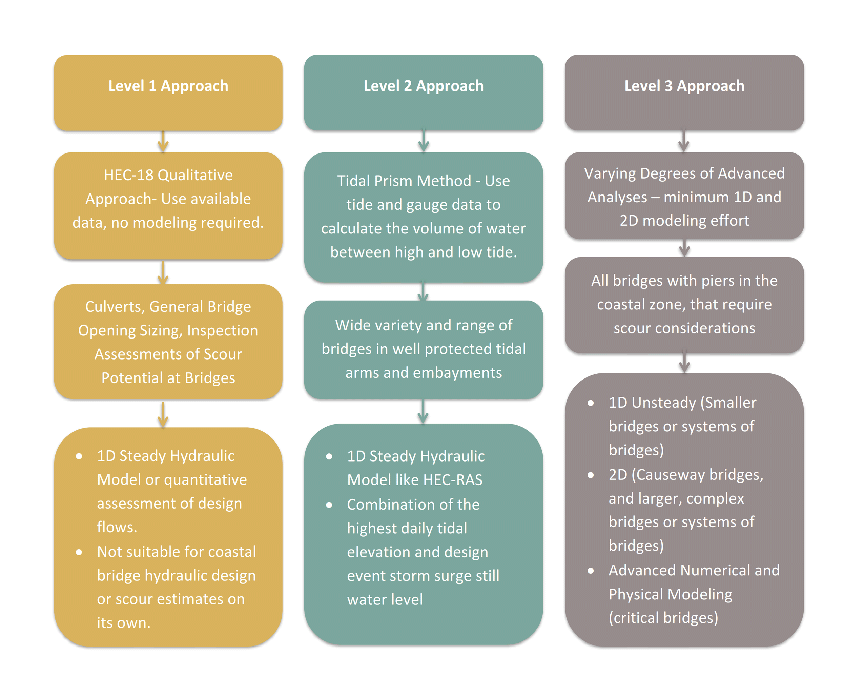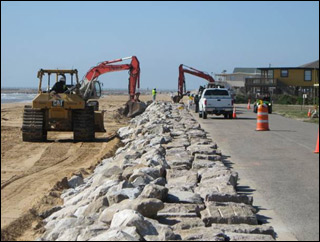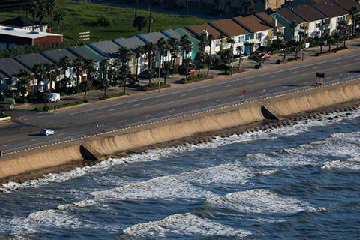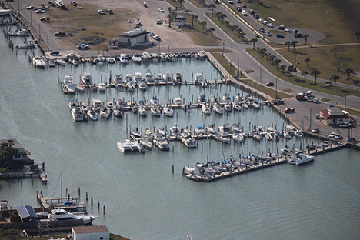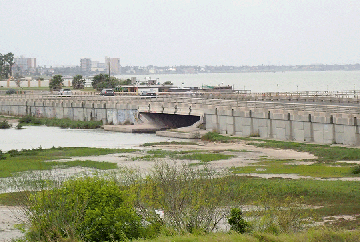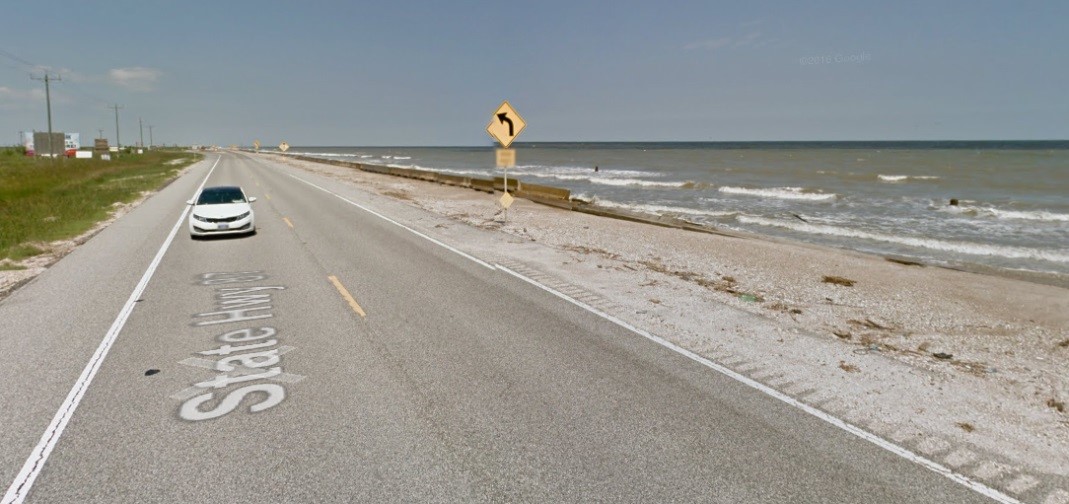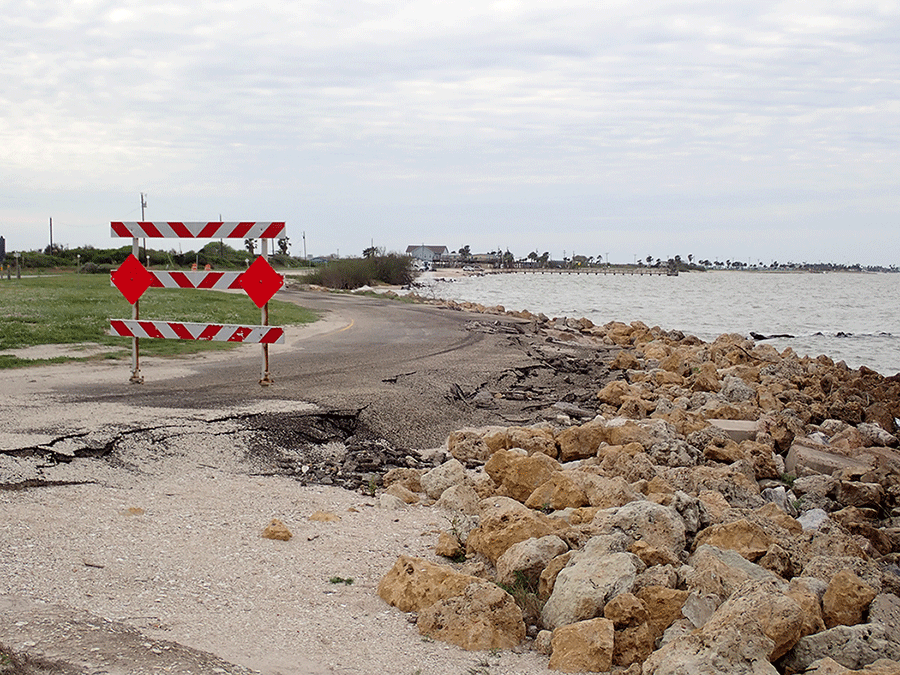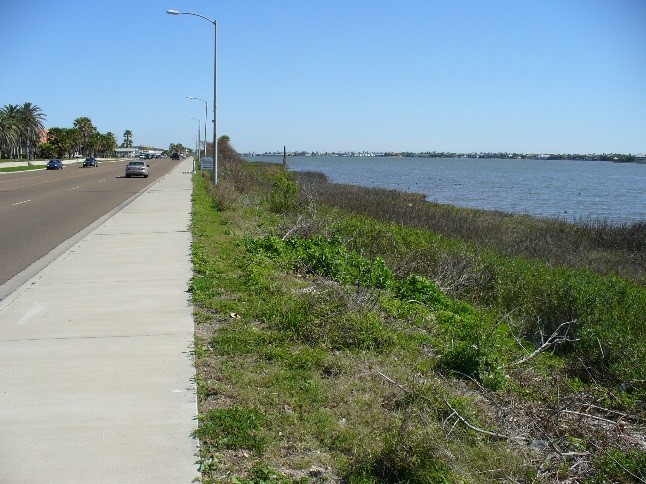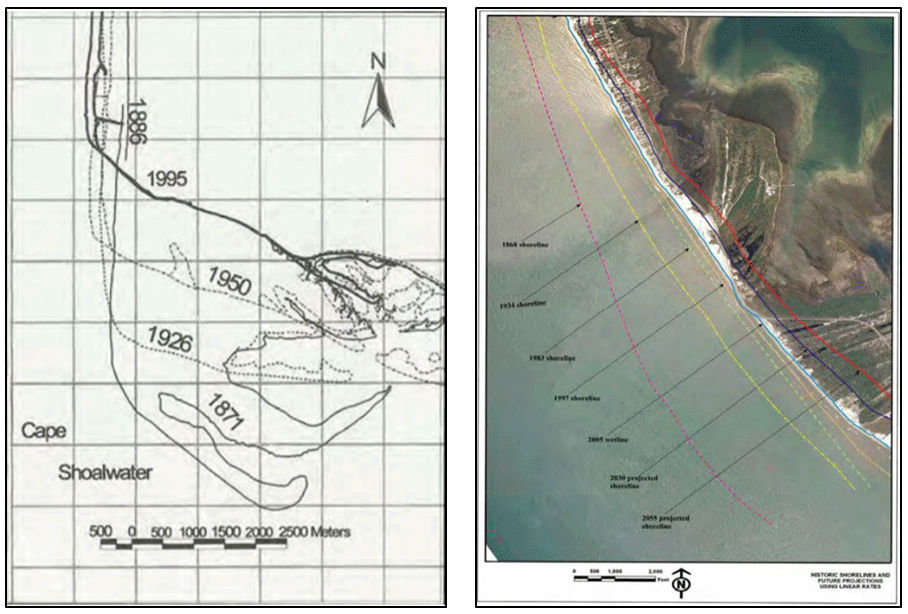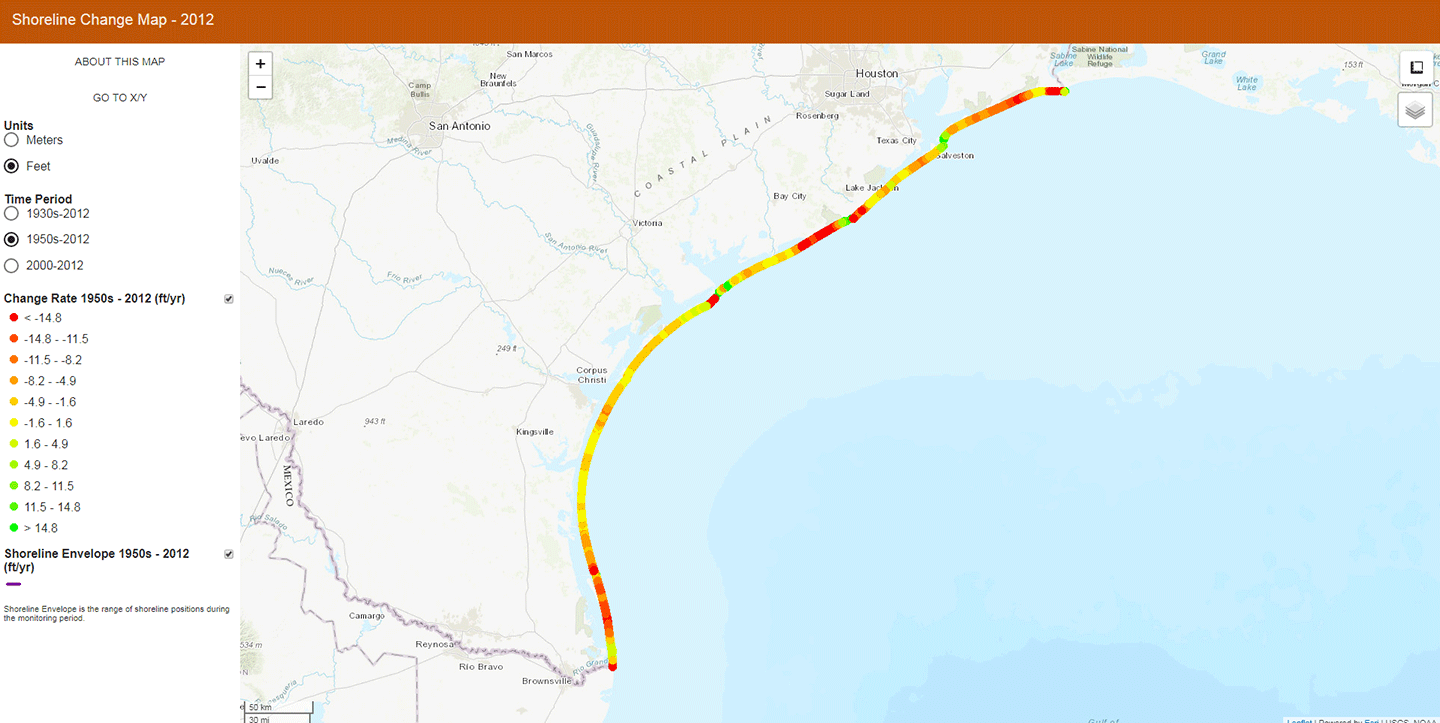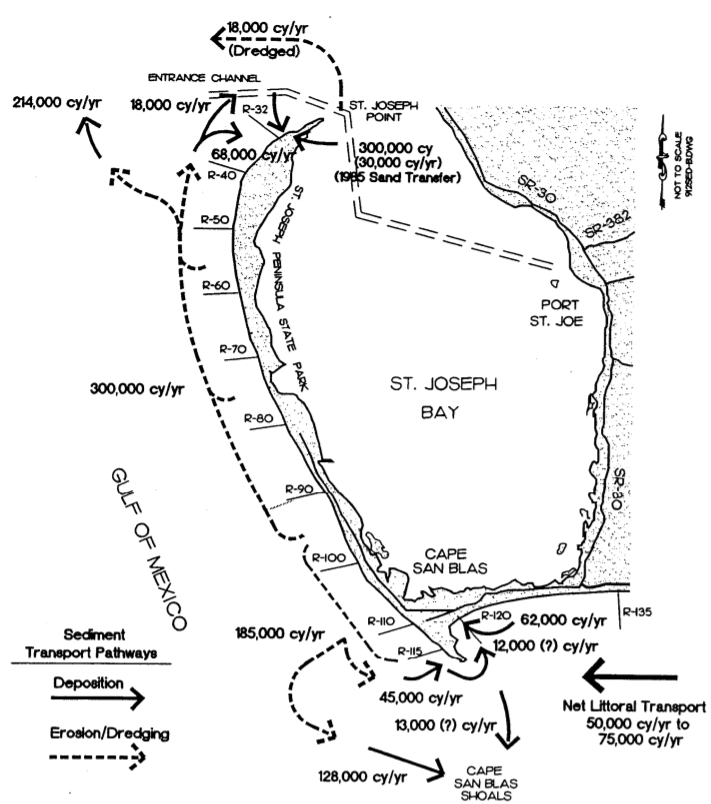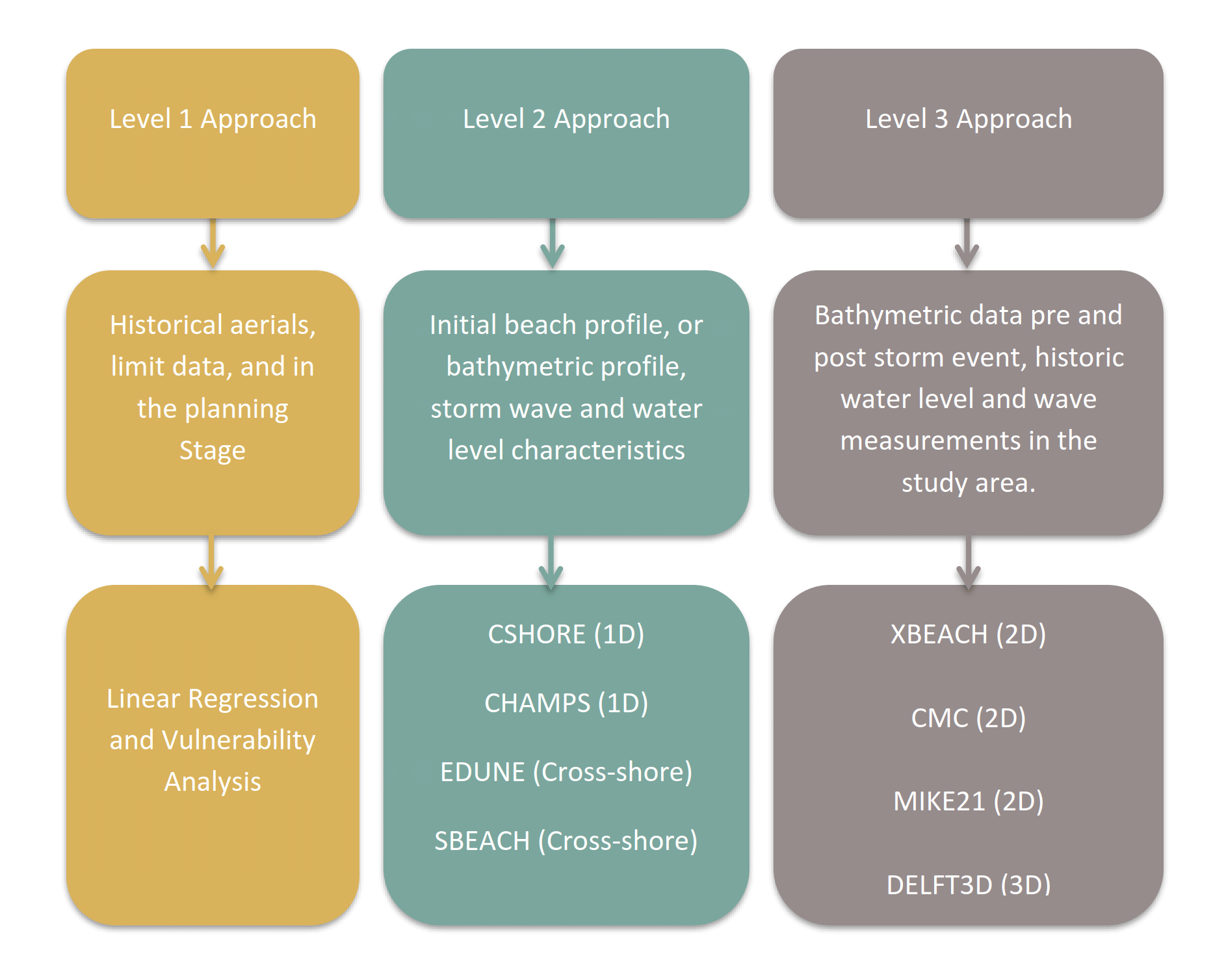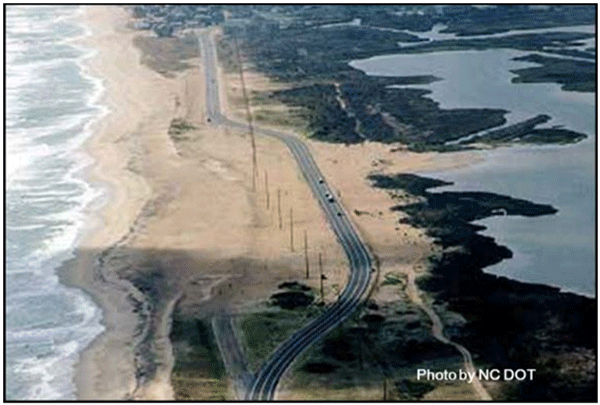Section 6: Erosion
Erosion in the coastal environment can take many forms, with the most common issues for coastal roadways resulting from scour and shoreline change. Scour is the local-scale removal of sediment at the base of a structure (or other stationary object) due to forces from moving water, the effects of which have the potential to expose or undermine the structural foundations or protective structures of a project. Although scour is a form of erosion, scour does not include the loss of sediment on a larger (often regional) scale, such as occurs with shoreline change. Large-scale changes in the shoreline can include both recession and accretion. In this section we will discuss the physical drivers of scour and shoreline change, impacts on coastal structures, mitigation measures, and data sources that provide additional guidance.
Anchor: #i1026526Scour
Scour is addressed elsewhere in this Manual for cases involving hydraulics for bridges (Chapter 9), reservoirs (Chapter 12), and storm water management (Chapter 13). Scour occurring in a coastal environment is fundamentally different than riverine scour. In the coastal environment, the primary driver of scour is from head differences across a structure driven by storm tide, which are propagating inland. Riverine scour is typically opposite in direction and is driven primarily by storm runoff, resulting in different mechanisms and directions for scour considerations. Many coastal structures require analyzing for both riverine and coastal scour, and some scenarios require evaluation of combined effects. HEC-25 classifies three levels of approach for coastal scour which will be discussed later. A Level 3 analysis should be evaluated by a precertified TxDOT engineer with experience in coastal processes.
This section focuses on scour due to coastal exposure including storm surge, waves, and tidal currents. Scour should be assessed or evaluated for most projects, especially in locations that may have significant water velocities at the large scale or localized levels. The potential for scour is influenced by a combination of factors including water velocity, structure configuration, bathymetry, bay/inlet configuration, sediment characteristics, and wave climate. Of particular interest for TxDOT projects is the potential for scour at bridges and roadway embankments. Scour can occur along roadway embankments from several scour mechanisms including wave action, weir-flow, and shoreline change. These mechanisms will be discussed in the next section.
All bridges need to be evaluated for scour (23 CFR 650.313(e) and FHWA, HEC-18, Evaluating Scour at Bridges). Especially susceptible locations are areas with abrupt changes in bathymetry, or tidal inlets that can cause flow constrictions or focus wave energy, and areas of active wave breaking. Other resources available to provide in-depth information, equations, and procedures to perform coastal scour include the First and Second volumes of HEC-25, Highways in the Coastal Environment, and HEC-18 (Sections 9.7 and 9.8).
Scour Mechanisms
Scour results from the erosive action of flowing water, which may remove and carry away material from the bed, banks of waterway, and from around coastal structures, such as piers and abutments. Different materials scour at different rates. Loose granular soils are rapidly eroded by flowing water, while cohesive or cemented soils are generally more scour-resistant.
Determining the magnitude of scour risk at structures in coastal waters is complex, as they are at the confluence of concurrent hydraulic forces (e.g., currents and breaking waves) that arise due to the interface of the land and water. Reviewing site conditions can lead to a better anticipation of the types of scour that may be present and should be evaluated. Once the types of existing structures or planned structures are known, the list of typical scour mechanisms can be reviewed for applicability. Table 15-10 lists common scour mechanisms. Examples of many of these mechanisms are also shown in Figure 15-21.
|
General Scour Mechanisms |
Additional Coastal Scour Mechanisms |
|---|---|
|
Scour around piers and abutments |
Roadway damage by wave attack |
|
Erosion along toe of highway embankment |
|
|
Erosion of embankment due to overtopping flow |
|
|
Long term vertical degradation of stream bed |
Roadway and railway damage by coastal “weir-flow” |
|
Horizontal migration of stream banks |
|
|
Debris impact on structure |
Roadway damage by bluff erosion and shoreline recession |
|
Clogging due to debris causing redirection of flow |
|
A - Partial embankment damage caused by wave attack |
|
B - Example of the weir-flow damage mechanism as it occurs |
|
C - Pavement damage due to waves and surge in an extreme event in Brazoria County after Hurricane Ike |
D - Two bridges destroyed by wave loads in Hurricane Katrina |
|
|
E - Wave scour hole formed by Hurricane Katrina |
||
Figure 15-21. Photo Examples of Coastal Scour Mechanisms (FHWA, 2008)
Hydraulic analysis must consider the magnitude of design storms, characteristics and geometry of the tidal inlet, estuary, or bay, and the long-term effects due to placement of the bridge or other transportation asset. Structures located in coastal environments must also consider scour resulting from flow in two directions due to tidal fluctuations. In addition, the analysis must consider the long-term effects of normal tidal cycles. This can be achieved by modeling and reviewing the time-dependent tidal flows, velocities, and depth on the following processes:
- Anchor: #XYGORDKN
- Aggradation or degradation. These processes are the long-term elevation changes, which can affect the reach of the waterway on which the bridge is located. Aggradation involves the deposition of eroded material from upstream of the bridge, while degradation is the lowering of the bed of the waterway due to a deficit in sediment supply upstream. Anchor: #EWUTLHQY
- Contraction scour. Contraction scour is the lowering of a waterway bed at the bridge location due to constriction of the flow. This differs from degradation in that contraction scour occurs in the vicinity of the structure. Worst-case conditions of contraction scour are typically the result of storm surges. Anchor: #MJGWCWMQ
- Local scour. Local scour involves removal of material around engineered structures caused by acceleration of flow and vortices induced by obstructions. Worst-case conditions of local scour are typically the result of storm surges. Anchor: #LWOFLHHB
- Channel instability. Lateral migration of the waterway occurs naturally and may affect the stability of engineered structures or change scour patterns. Channel stability is affected by local geomorphology, flood characteristics, and bed/bank materials. HEC-20 and FHWA’s Hydraulic Design Series Number 6 ( HDS 6) provide guidance on incorporating channel stability into roadway design.
Geotechnical investigations are commonly used to evaluate scour mechanisms. Understanding the local soil and rock properties is important, as it provides a basis for describing common engineering properties of geomaterials and how different materials may behave under various conditions. Geotechnical investigation can include surface samples, borings, and SEDflume testing. Surface samples and boring can be evaluated via Unified Soil Classification System (USCS) classifications, gradation, plasticity index, and hydrometer testing.
Due to the dynamic nature of sediment transport in the coastal zone, most technical guidance is based on empirical equations, experience, and field observations. The type of sediment located throughout the study area and suspended in the water column should be considered and equations based on available data used as appropriate. One area of focus that can vary the level of analysis needed or types of equations used is the type of soil to be evaluated, such as cohesive, non-cohesive, coarse, or erodible rock. For non-cohesive material scour equations, it is important to know the D50 and D90 sediment diameters. For cohesive materials, when possible, it is important to know the erosion rate and critical velocity of sediment particles. These values can also be derived empirically if the D50 and classification are known.
Long-term sediment budgets are also important for understanding areas prone to scouring. The long-term sediment budget can be generally characterized by typical sediment movement within the littoral zone. The littoral zone is the zone from the shoreline to just beyond the breaking wave zone. Littoral drift is the movement of beach material in the littoral zone by waves and currents. An aggrading or stable waterway may exist if the sediment supply to the project area from the littoral drift is large. Such a situation may minimize the effect of contraction scour, and possibly local scour. Conversely, long-term degradation, contraction, and local scour can be exacerbated if the sediment from littoral drift is reduced. Important information for evaluating the effect of littoral drift includes historical information, future (dredging, installation of jetties, etc.), and sources of sediment. The Shoreline Change subsection provides a more in-depth discussion for long-term shoreline change and sediment budgets.
Once the project location is determined to be coastal (as described and shown in the maps in Section 1), the asset type to be designed or evaluated is chosen (such as a bridge), and the site’s geotechnical background is developed, then the scour mechanism(s) that apply can be evaluated. Besides the list in Table 15-10, the USACE CEM provides examples of locations that have a high potential for coastal scour (Figure 15-22). Other methods of determining the observed or potential scour mechanism include reviewing maintenance reports, reports from community engagement, and photos after storms.
Figure 15-22. Locations with High Potential for Coastal Scour (USACE, 2002)
Guidance on methods for evaluating scour analysis in tidal waterways are outlined in HEC-18, HEC-20, HEC-23, HEC-25, and USACE CEM.
Understanding sediment budgets and geomorphic existing conditions provides a valuable tool for evaluating the potential for scour in tidal waterways. In most cases, this principle is not easy to quantify without direct measurements and hydraulic modeling. For the analysis of roadway structures located in tidal waterways, a three-level analysis approach, similar to the approach outlined in HEC-20, is recommended. Determining the appropriate level of analysis is dependent on-site conditions, level of approach, available data, and potential applicable scour mechanisms.
- Anchor: #DOALRGSM
- Level 1 Analysis — Includes a qualitative evaluation of the stability of the inlet or estuary, estimating the magnitude of tides, storm conditions, flow, and long-term stability of conditions in the waterway. It is appropriate for planning phases and deliverables where uncertainty is acceptable. A Level 1 analysis is not appropriate for coastal bridge hydraulic design or scour estimates. However, a Level 1 approach can be useful in the asset management and planning phase, or when determining the potential level of effort required for a specific project. Anchor: #QMDDHMDM
- Level 2 Analysis — Represents the engineering assessment necessary to obtain the velocity, depths, and discharge for tidal waterways to be used in determining long-term aggradation, degradation, contraction scour, and local scour. A Level 2 analysis is suitable for a wide range of bridge sizes and types. A Level 2 analysis, when applied over the tidal prism (or volume of water contained in a tidal inlet between low and high tide levels), does include a level of uncertainty but can provide generally conservative estimates of potential scour. A Level 2 analysis is not recommended for bridges at inlets or causeway bridges. Anchor: #VFXLPOBE
- Level 3 Analysis — Is used for complex tidal situations that consider a larger area and a higher range of storm conditions. A Level 3 analysis can vary in complexity from one-dimensional unsteady model to advanced and physical modeling. In general, the more complex the flow parameters, the more advanced the model. HEC-25 provides more information regarding advanced tidal hydraulic modeling approaches.
Figure 15-23 summarizes the guidance on level of approach as it pertains to scour estimation methods.
Figure 15-23. Scour Methods and Corresponding Level of Analysis.
Scour Mitigation Measures
There are several methods of infrastructure adaptation that can be incorporated during planning, designing, construction, operating, or maintaining infrastructure to mitigate for coastal scour. HEC-25 recommends a five-part approach: manage and maintain, increase redundancy, protect, accommodate, and relocate. Table 15-11 summarizes each of the five steps in the recommended approach.
|
Manage and Maintain
|
Increase Redundancy
|
|
Relocate
|
Accommodate
|
|
Protection
|
|
If an existing transportation asset is identified as at risk to erosion, then protection might be the first option to immediately mitigate risk. All options can be reviewed and incorporated for proposed transportation assets. For general scour conditions, such as local scour, contraction scour, stream instability, and overtopping flow, refer to Table 2.1 (Stream Instability and Bridge Scour Countermeasure Matrix) in HEC-23 for guidance on reviewing the hydraulic countermeasures, structural countermeasures, biotechnical countermeasures, and monitoring as part of a scour evaluation. Since those measures are applicable for the above conditions and more well-known in riverine analysis, the remainder of this section will focus on examples of coastal protection and countermeasures.
Roadway Mitigation
Many different natural processes and forces impact roads near the coast. This section will focus on the most common erosion issues (e.g., overwashing, coastal weir-flow damage, and wave action) for roadway infrastructure.
Overwashing:
For roadways in coastal environments, highway overwashing is a very common occurrence due to nearshore locations and low elevations. There are several mechanisms that damage pavements subject to overwash including:
- Anchor: #LABWTPKY
- Direct wave attack on the seaward shoulder of the road; Anchor: #KDJBWVDA
- Flow across the road and down the landward shoulder or “weir-flow”; and Anchor: #YTOADUDI
- Flow parallel to the road as water moves to “breaches” or lower spots in the road as the storm surge recedes.
Coastal weir-flow and wave action will be discussed as they relate to impacts from these mechanisms later in this section.
Strategies for minimizing damage during the overwashing condition include:
- Anchor: #HTJQQMCI
- Bayside Location — Relocating the road to a portion of the barrier island where sand will likely bury the road during overwash. Anchor: #UDITXFIS
- Low Elevation — Lowering the elevation of the road to be at or below much of the existing grade to encourage burial by sand during overwash. This will protect the pavement from high velocities and flows that can break-up the pavement and damage the bayside embankment. Anchor: #YQPRLMRH
- Dune Construction — Constructing a sand dune seaward of the road to reduce the likelihood of overwashing and to provide a reservoir of sand to bury the pavement when overwashing occurs. Anchor: #THRDRIQG
- Armoring — Armoring of the shoulders of the road to resist erosion during overwashing.
Figure 15-24, below, shows the first three strategies in a roadway cross section view.
Figure 15-24. Schematic Summarizing Three Approaches (Bayside Location, Low Elevation, Dune Construction) to Minimize Damage to Roads that Overwash (FHWA, 2008)
Coastal Weir-Flow Damage:
One scour mechanism that damages pavements during overwashing is the coastal weir-flow damage mechanism. During this mechanism, water overtops the roadway embankment. The embankment acts as a broad-crested weir to the incoming storm surge. The water that flows over the embankment can become supercritical as it reaches the edge of pavement and have a free fall or a high tailwater condition. It is likely that waves will exacerbate the weir-flow damage mechanism and increase the scour risk. This happens when waves moving across the pavement with the storm surge increase the instantaneous flow velocities on the downstream shoulder. In addition to incoming storm impacts, the embankment can act as a broad-crested weir and experience similar damage mechanisms as storm surge recedes. There is also a concern of uplift on overtopped pavements due to a potential increase in underlying pore pressure in the sandy base materials.
Mitigation measures for weir-flow are similar to general overwashing. Lowering the roadway elevation to an elevation at or below adjacent ground elevations can prevent weir-flow from occurring, since the crest of the pavement is no longer the highest portion of the grade. In addition, considerations can be incorporated into the pavement design to mitigate pore pressure increases. Armoring the shoulder to withstand weir-flow mechanisms is recommended where lowering the roadway is not possible.
Wave Action:
Waves, as discussed in Section 3, cause some of the primary hydraulic forces on coastal roadway embankments. Some key variables that are often considered in revetment design to protect roadways include design wave height, potential for wave runup, and potential for overtopping splash. Where wave action and wave runup are a concern, revetment, seawalls, and bulkheads may be considered for shoreline or roadway embankment protection, as previously discussed. Relocation further inland can also reduce impacts of wave action.
Coastal Armoring for Wave Attack
Revetments, seawalls, and bulkheads are all coastal protection features designed to protect roadways and other coastal assets from dynamic coastal processes as shown in the examples in Figure 15-25. The preferred use of each option is dependent on the local conditions. Revetments are layers of protection on top of a sloped surface to protect the underlying, elevated soil. Seawalls are free-standing structures that can be stable at greater heights than revetment and are designed to protect against large wave forces. Bulkheads are designed primarily to retain the soil behind a vertical wall and are primarily used in areas with limited wave action. The fetch is a length of ocean or lake over which the wind blows in a constant direction. Given the relationship between wave height and fetch, the flowing discussion distinguishes between the three types of coastal protection and their applicability:
- Anchor: #MNVJRBGG
- Bulkheads are most common where fetches and wave heights are small, because they have limited capacity to protect against large wave forces. Anchor: #XPSXPGEL
- Revetments are often found in intermediate situations, such as along bays or lakes. Most transportation projects throughout Texas will rely on revetment to protect low-lying roadways, since the wave action protection provided by revetment is needed, but the height of a seawall is not required. Anchor: #GKUKANSU
- Seawalls are most common where fetches and wave heights are very large, because the free-standing structures can be designed high enough to withstand larger waves and be generally more stable than revetments.
Although these three structural alternatives are the traditional approaches to coastal armoring, combinations of them with softer methods, as later discussed, are becoming more viable and can often provide more dynamic long-term protection. It is important to note that the more robust the structural alternative, such as a seawall, the more likely for residual shoreline or structural erosion adjacent to the project site. Residual impacts should be considered when evaluating project solutions.
|
A - Revetment construction along CR257 in Brazoria County, Texas (Apollo Environmental) |
B - Galveston Seawall (Houston Chronicle) |
|
|
C - Bulkheads protecting roadways in Aransas County, Texas |
D - Vertical walls provide roadway protection along this Ocean Drive crossing in Corpus Christi, Texas |
Figure 15-25. Examples of Shoreline Protection.
A well-designed and constructed revetment can protect roadway embankments from waves. The rubble is efficient at absorbing wave energy and any damage that the revetment receives is often inexpensive to repair. HEC-23 and HEC-25 provide detailed procedures for the design of stone revetments and recommend Hudson’s equation to estimate stone size for the outer layer of rock revetments subject to wave action. Hudson’s equation accounts for the most important variables, including design wave height, structure slopes, and different stone densities and angularities. HEC-25 provides a more detailed description of calculations for the design wave heights for revetment design. HEC-25 also provides examples for the applicability of design alternatives depending on specific project site conditions and requirements.
Some revetment design failure mechanisms include: inadequate armor layer design for wave action, inadequate under layer, flanking, toe scour, and overtopping splash (Figure 15-26).
|
A - Toe Scour causing concrete median barriers to topple along the shoreline adjacent to SH87 near High Island, Texas |
|
B - Inadequate Armor Layer - A revetment with rocks too small to withstand wave attack along SH316 in Calhoun County, Texas |
Figure 15-26. Examples of Failed Shoreline Protection.
To prevent failure mechanisms, precaution should be taken when applying design equations, like from HEC-23 or HEC-25, to ensure values used represent the intent of the equations. Stone should be sized to ensure wave action is appropriately addressed. Toe design should have significant depth of stones to prevent undermining. The protection should tie back into natural structures or adjacent resistant structures to prevent flanking and should extend high enough to prevent overtopping splash damage. The biggest risk is exposure of the underlying soil. Concrete block and panel revetment have not had a good performance record in severe coastal environments; neither approach matches the performance and flexibility of stone revetment (FHWA, 2008).
New technologies are emerging for scour protection; some examples include scour control mats and geo-fabric stone bags. As case studies develop and results are reviewed, these technologies might serve as an additional option for shoreline and structure protection (Figure 15-27).
Figure 15-27. Cellular Concrete Mattresses Protecting a Coastal Highway in Calhoun County, Texas.
Other hard coastal structures that are successful in shoreline protection include groins, breakwaters, and hybrid structures (Figure 15-28). Groins are narrow, roughly shore-normal structures built to reduce longshore currents, and/or to trap and retain littoral material. Breakwaters are structures protecting a shore area, harbor, anchorage, or basin from waves. Hybrid structures are some functional combination of groins, breakwaters, or structural measures functioning in a complementary fashion. Further studies need to be conducted on all coastal protection measures, but redundancy in protection methods should be considered for adaptive designs in coastal environments.
Living shorelines, discussed more in Section 6, are techniques that involve combining ecologically-based, “soft” mitigation techniques, such as coastal vegetation, with hardened solutions, such as breakwaters. This is also a more adaptable system that can potentially provide improved long-term mitigation due to its more dynamic response to future coastal change (e.g., vegetated features can migrate with sea level rise). One example of a soft coastal protection method along roadways is beach nourishment, particularly on Gulf shorelines. Placing sand to widen a beach along with hard coastal structures can lead to a great balance between structural needs and environmental conditions to mitigate erosion.
|
A - Wetlands and submerged oyster reef barriers provide living shoreline protection for Broadway Street in Aransas County, Texas |
|
B - Groin fields shelter local roadways in Calhoun County, Texas |
Figure 15-28. Examples of Alternative Shoreline Protection Strategies.
Coastal Bridge Scour Mitigation
Engineering coastal bridges can be complex and requires consideration of forces and processes unique to the coastal environment, including tidal bridge scour and hydrodynamic loads from waves and tidal currents. The types of scour that occur at bridges in the coastal environment include the same general categories as found at riverine bridges. However, in the case of coastal bridges, scour can potentially be caused by more varied directions and magnitudes, thus increasing the complexity of analysis. Additionally, coastal bridges can experience scour as a result of wave action (wave scour) and localized areas of high velocity flows.
Methods of design equations to consider in coastal scour evaluation can be found in HEC-18, HEC-20, HEC-25, and the USACE CEM. Scour as defined for coastal bridges is broken into three approaches per HEC-25. For a level 3 approach as shown previously in Figure 15-23 where advanced modeling is needed because of the variety of nearshore processes, a precertified TxDOT coastal engineer should be involved. Each design storm or nearshore process scenario that is simulated should be considered for impacts on scour. Combinations of different physical processes that could increase the scour rate should be considered. For instance, if a bridge experiences tidal, wave, and storm surge conditions as part of the design storm scenarios, the hydrodynamic impacts of each condition above should be reviewed for variables like water elevation, velocity, depth, and other factors needed in scour evaluations.
Guidance documents for countermeasures included in HEC-23 apply for coastal areas as they do for riverine, and include: Design Guideline 11 - Rock Riprap at Bridge Piers and Design Guideline 17 - Riprap Design for Wave Attack. In Texas, riprap often refers to concrete; in FHWA guidance, riprap is typically equivalent to stone revetment. For the purpose of this chapter, riprap directly referencing a design guideline title means stone revetment.
Stone revetment is a common revetment countermeasure at bridge piers and abutments. Stone revetment should follow HEC-23 Design Guideline 4 - Riprap Revetment for guidance on sizing, gradation, placement methods, and failure mechanisms. Some failure mechanisms of stone revetment include: particle size being too small, channel changes like migration or channelization, improper gradation, improper placement, and lack of or inadequate filter. To avoid the failure mechanisms, attempts should be made to evaluate variables used for appropriateness when applying equations to size stone revetment, and any channel changes as evaluated per HEC-20 should be considered in the application for the design life of the bridge. Similar to riverine applications, HEC-23 for countermeasure design can be utilized for coastal applications methods, but all available coastal inputs should be considered and applied in the design (such as tides, wave, and storm surge).
Scour Data Sources
- Anchor: #IRWTFQEB
- Federal
Highway Administration
- Anchor: #XWVYOCCC
- HEC-18 – Evaluating Scour at Bridges — Chapter 9 of HEC-18 provides information on scour as a result of tidal currents and potential related considerations. The document outlines three levels of analysis ranging from a Level 1 qualitative analysis to a Level 3 quantitative analysis including physical models or sophisticated numerical models. Anchor: #KJGOEKSL
- HEC-20 – Stream Stability at Highway Structures — Chapter 2 of HEC-20 discusses geomorphic factors and principles, and while geared toward riverine environments, the same considerations should be applied to evaluate coastal or lake shoreline stability. Chapter 4 discusses analysis procedures for stream instability, including a discussion on mathematical and physical model studies. This would be used during a scour evaluation required by 23 CFR 650.313(e) to evaluate stream stability. Chapter 5 discusses stream reconnaissance techniques which can apply to coastal conditions in the method of data collection and conducting a field visit. Anchor: #EMSYNGBY
- HEC-23 – Bridge Scour and Stream Instability Countermeasures Experience, Selection, and Design Guidance — Design Guideline 17 in HEC-23 provides guidance for stone revetment design for sites subject to wave action. Other Design Guidelines within HEC-23, can also be useful in coastal applications. Anchor: #NKCCDFTM
- HEC-25 – Highways in the Coastal Environment — HEC-25 discusses scour at coastal bridges and provides descriptions of the multiple ways that a bridge can experience scour due to different geometries. Also discussed are the time-dependent nature of scour and the influence of longer storm events.
Anchor: #LXMNRLCC - USACE Coastal Engineering Manual — The “Scour and Scour Protection” chapter of the CEM provides background on the dynamic nature of coastal scour and presents several empirical methods to estimate potential scour. The chapter also discusses common structures and geometries that may induce scour. Anchor: #SQGOHLIW
- TxDOT Geotechnical Manual — Chapter 5 (Foundation Design), Section 6 (Scour) of the TxDOT Geotechnical Manual notes that the guidelines outlined in HEC-18 should be used. Section 6 (Scour) also provides minimum design flood frequencies to be used for scour design. Although guidance was not separately developed for coastal settings, the same theory may be applied once controlling conditions are determined. The primary difference in using these equations for coastal settings is the need to better define input velocities and wave conditions based on the two- and three-dimensional nature of coastal hydrodynamics (for example, tides cause ebb and flood flow in tidal channels, whereas riverine flow is almost always downstream).
Shoreline Change
Shoreline change can be long-term, short-term, or storm induced/episodic and is often expressed in terms of the average change in shoreline position with time (e.g., 1 foot per year). Shoreline change can also occur in several directions, including moving landward (recession) or seaward (accretion). Shoreline change differs from scour in that a scour analysis focuses on structural assets, like a roadway or bridge, while shoreline change is a large-scale view of a section or region of coastline. The difference between coastal scour and coastal shoreline change is similar in principle to riverine contraction and local scour of structural assets, as compared to the long-term aggradation and degradation of the stream bed and lateral stream migration in riverine systems.
Dynamics
Wind, waves, and currents are the primary forces that move sediment and larger stones. If a change occurs in the pattern of winds, waves, currents, or sediment supply, then shoreline change can occur. Another impact that can change the forces listed above is variation in the sea level. Changes in sea level, discussed in Section 2, can affect where the shoreline and nearshore processes occur and influence the shoreline elevation and width. The presence of shoreline features, such as tidal inlets and coastal engineering structures (e.g., jetties and breakwaters) can also affect shoreline change, as they can exacerbate or attenuate wave and current conditions, depending on their location.
Episodic or storm-induced shoreline change can cause significant retreat or impacts to a shoreline. An individual storm may cause significant erosion or even trigger the beginning of an erosional period (an erosional period is a short-term change that may not relate to or follow long-term shoreline trends). Specific to Gulf shorelines in Texas, large storms on low-lying barrier islands can cause island rollover and migration, or in some locations may remove large amounts of sand from the beach. Island rollover and migration occurs as storm surge moves sediment along the barrier islands landward. It can take years for a Gulf shoreline to naturally recover from a storm, although sometimes the culmination of lesser storm activity can result in the replacement of much of the sand that was lost. It should be noted that storm-induced erosion of bay shorelines is not typically followed by any shoreline recovery, as bay shorelines are commonly clay- and bluff-based shorelines that do not have the dynamic ability to recover as a Gulf sand-based shoreline does.
Beyond storm-induced changes, long-term changes along Texas coastlines are driven by sediment movement and the typical annual current and wave conditions, or even typical vessel wakes. These long-term trends are more frequently recognized at the regional level, particularly for Gulf shorelines. Most Texas Gulf shorelines are considered eroding over the long-term, with some net neutral or accreting locations near the central Texas coast. This is the result of a general trend for net positive longshore sediment movement towards the central Texas coast; however, there are localized exceptions resulting primarily from groin structures interrupting the natural occurring sediment movement.
Quantifying Shoreline Change Rates
Shoreline change rates vary along the Texas shoreline and through time. When evaluating shoreline change rates, it is important to consider all available observations and as long of a period of record as possible. Long-term shoreline change typically refers to historic time scales where measurements were recorded (e.g., 1800s to present) and is useful for understanding potential impacts to roadway infrastructure through the coming century. In contrast, short-term shoreline change is typically calculated using recent multi-decadal timescales (e.g., 1970s to present). Understanding short-term shoreline change is useful for evaluating impacts to a project that may occur at an earlier planning time frame, or if the project is in an area that has been largely influenced by human activity, such as engineering shoreline protection structures, in recent decades.
While there is no national or state standard for shoreline change analyses, there are common approaches to quantifying changes. Mapped historical shoreline positions are often used to interpret the movement of shorelines through time, and linear regression statistical approaches are useful to approximate change rates that vary along the shoreline (Figure 15-29). Observed rates are commonly extrapolated into the future to assess future long-term impacts at design sites. This approach is especially valuable when planning the future location of highways located in areas with receding shorelines.
Figure 15-29. Example of Historic (left) and Projected Future (right) Shoreline Positions (FHWA, 2008)
Historical shoreline data for Texas Gulf shorelines is primarily documented through the Texas Shoreline Change Project managed by the Bureau of Economic Geology (BEG) at the University of Texas (Figure 15-30).
Figure 15-30. Shoreline Erosion Map Interface for BEG Gulf Shoreline Tool (as of 2012)
Bay shoreline data is not widely available within Texas for historical rates, and frequently the best alternative is to utilize historical imagery to identify trends, with Google Earth serving as the primary option.
Some limitations to using historic shoreline change rates to estimate future shoreline position include:
- Anchor: #UKIJVFKR
- Shoreline processes are often not linear with time; Anchor: #SDJNQCIU
- Human influence may have influenced historic shoreline changes; Anchor: #UNSTAJXS
- Human influence may influence future shoreline change; and Anchor: #REFBOOYM
- Data collected is limited to human record timeframes.
Local sediment budgets play a large role in the dynamics of shoreline change. Sediment budgets describe the input, transport, storage, and export of sediment along the shoreline. Whether evaluated quantitatively or qualitatively, all sediment budgets are conceptually understood by a continuity equation stating that during a given time period, the amount of sediment coming into the area minus the amount leaving the area equals the change in the amount of stored sediment. Historical aerial imagery as well as survey can be used to evaluate long-term trends in the shoreline as mentioned above but review of the sediment budget can also be used to estimate future shoreline positions.
Sediment budgets typically require much more data and analysis than simple shoreline change extrapolation. Aerial photography and remote sensing can be used to quantify visual and volumetric changes in sediment along a shoreline. In addition, sediment sampling in the water column and along the seafloor can be combined to develop data needed for sediment transport models. In the mapping or quantifying of sediment transport, specific erosion problems can be identified or better understood in order to develop appropriate site-specific solutions. Figure 15-31 is an example of a sediment budget evaluation and map. The sediment budgets were determined through volumetric methods that evaluated the beach profile changes from 1973-1997.
Figure 15-31. Example of a Coastal Sediment Budget (FHWA, 2008)
Numerical Modeling of Shoreline Change
In addition to prorating historical trends of shoreline change, numerical models have been developed to estimate future shoreline positions. Few numerical models can accommodate all of the design factors discussed in this chapter within the same model. Models also vary in their degree of complexity, ranging from 1D to 3D capabilities. Sediment transport models have more inherent uncertainty than hydrodynamic models, as they must consider additional factors such as sediment grain size and sources/sinks of sediment. Figure 15-32 shows inputs per level of analysis and available modeling for each level.
Figure 15-32. Shoreline Change Level of Analysis Inputs and Applicable Models.
The most common method for estimating future shoreline positions is direct extrapolation of historic shoreline change rates to the present shoreline from historic maps and aerials. Shortcomings in this method include the fact that shorelines change processes may not be linear with time; it is difficult to tie the shorelines to a specific datum, engineering may have impacted shoreline change in the past and may impact future change. If an area is rural and has experienced minimal engineering design along its coast, then historic maps and aerials can be appropriate for shoreline change. If shoreline change and modeling is required for a large study area with many engineered structures and recorded shoreline change, it is usually necessary to use a highly advanced model to achieve the sediment transport detail needed for design.
Dredging can play a large role in shoreline change and especially in sites adjacent to the GIWW. Sargent Bridge in Texas is an example of an abutment being designed for future dredging depth and impacts, rather than current conditions. This bridge site and the large area impacted by repeated or planned dredging would be a candidate for advanced modeling to evaluate shoreline change and sediment transport.
The type of project may dictate when to choose between a long-term and a short-term analysis. When evaluating short-term shoreline change due to extreme events, such as hurricanes, available data may limit the type of approach. The validation and calibration of such short-term shoreline change models is only possible when the available data, such as shoreline positions and elevations, are available both before and after the storm event. Modeling a short-term change is needed to calibrate the model to review long-term changes. Long-term change models can then include several probable storm events. Such data has become more common thanks to technological advancements in elevation data collection. Pre-storm and post-storm shoreline position and elevation data are available in limited locations for some recent storms in the form of coastal LiDAR data. Data can be obtained from the NOAA Coastal Services Center Digital Coast web portal.
Impacts on Coastal Structures
Roadways and other transportation assets along the coast are vulnerable to shoreline change (Figure 15-33). Once shoreline change has been identified as a design factor impacting a roadway asset, the vulnerability should be assessed. One method to determine vulnerability is to map the elevation and shoreline positions near structures versus the long-term recession rate (the long-term recession rate is the long-term shoreline change at an area that is determined to be recessing landward), using methods previously outlined. The less time a structure has until exposed by shoreline recession, the greater the potential vulnerability. This approach should also be combined with consideration of short-term or storm-induced erosion to help prioritize structures with a high potential for exposure to erosion. Early consideration is highly beneficial for planning repair, protection, or relocation strategies. If possible, transportation structures vulnerable to shoreline change should be considered for relocation to a landward position. However, if relocation is not an option due to adjacent private property, environmental concerns, or other issues, engineered shoreline stabilization combined with monitoring may provide long-term protection.
|
Relocation example in North Carolina (FHWA, 2008) |
|
Road destroyed by shoreline recession: SH87 in Jefferson County, Texas was destroyed during Hurricane Ike. Due to shoreline retreat, it is not viable to be rebuilt in its current location. |
Figure 15-33. Examples of Roadways affected by Shoreline Change.
As discussed in the Scour Mitigation Measures subsection, stabilization or remediation can be achieved through both hard engineering (e.g., seawalls, groins, breakwaters, and hybrid structures) or soft engineering measures (e.g., beach nourishment, dune regeneration, creating marshland, and vegetative plantings). A combination of techniques is often most effective in ensuring success. Mitigation measures for shoreline stabilization are similar to mitigation for scour but should be viewed on a broader scale in terms of sediment transport. Right-of-ways are often narrow, and joint efforts or partnerships may be required for roadway revetment and combination of hard and soft protection.
Shoreline Change Data Sources
- Anchor: #NYBYSBAC
- U.S. Geological Survey — USGS provides historical shoreline positions and calculated short-term and long-term shoreline change rates for many areas along the Gulf Coast. http://coastal.er.usgs.gov/shoreline-change/ Anchor: #QXUXTOTC
- NOAA Coastal Services Center Digital Coast — Data is available through NOAA Digital Coast web portal. https://coast.noaa.gov/digitalcoast/ Anchor: #LDPQFBAL
- University of Texas Bureau of Economic Geology — The Texas General Land Office, working with the University of Texas BEG, maintains and updates coast-wide erosion rates for Texas Gulf shorelines to estimate the areas of greatest long-term shoreline change in Texas. This information can be reviewed on their interactive map. http://www.beg.utexas.edu/research/programs/coastal/the-texas-shoreline-change-project. Anchor: #MOWAGOWH
- Federal Highway Administration — HEC-25 discusses quantifying shoreline change rates and provides descriptions of the multiple ways that a roadway and shoreline can experience shoreline changes. Also discussed are the modeling methods for analyzing shoreline change.
